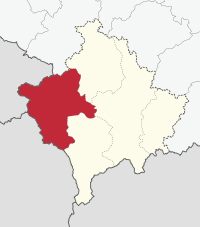Peć District (Serbia)
| Pećki okrug Пећки округ |
|
|---|---|
| District of Serbia | |
 Location of Peć District (Kosovo) in Kosovo |
|
| Capital | Peć |
| Population (2002 census) | |
| • Total | 414,187 |
| ISO 3166 code | RS-26 |
| Municipalities | 5 |
The Peć District (Serbian: Пећки округ or Pećki okrug pronounced [pêːt͡ɕkiː ôkruːɡ], also called Dukagjin or Regjioni i Pejës in Albanian) was a district in Kosovo between 1990 and 1999. It was located in the west part of Kosovo i Metohija. 90% of its population of 414,187 is Albanian, but there also live another ethnic groups such as Serbs, Roma, etc. Seat of the District was in the city of Peć. From one point of view of the Serbian government the district de jure still exist, despite the fact that Serbian government accepted civil UN administration over Kosovo.
It included the municipalities of:
Peć is first mentioned in 1302, as Archiepiscopal seat of the Serbian Orthodox Church. The Patriarchal Monastery of Peć consists of a group of monasteries and has been the seat of the Serbian Archbishops and Patriarchs for centuries. It is famous for its monastic complex in Peć, the official residence of the Patriarchs of the Serb Orthodox Church. In 1557, Serbian Patriarchate of Peć was restored by the Muslim Serb Mehmed Paša Sokolović from eastern Bosnia, who was the Ottoman Vizier. In 1766, Serbian Patriarchate of Peć was abolished.
The frescoes from the church of St. Apostles, dating from the thirteenth century, rank among the most remarkable medieval Serbian paintings. Over the centuries, churches and other buildings of the Peć Patriarchy have been destroyed and reconstructed several times. Today's appearance dates back to 1931-1932. The Visoki Dečani Monastery is one of the most grandiose monuments of the Serb medieval culture. It is the endowment of King Stefan Dečanski, built from 1327 to 1335.
...
Wikipedia
